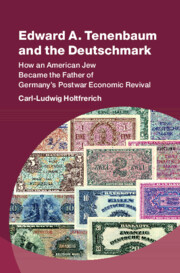Refine search
Actions for selected content:
26946 results in Economic history
Figures
-
- Book:
- Edward A. Tenenbaum and the Deutschmark
- Published online:
- 19 October 2024
- Print publication:
- 31 October 2024, pp ix-xiv
-
- Chapter
- Export citation
Dedicated to
-
- Book:
- Edward A. Tenenbaum and the Deutschmark
- Published online:
- 19 October 2024
- Print publication:
- 31 October 2024, pp v-vi
-
- Chapter
- Export citation
Acknowledgments
-
- Book:
- Edward A. Tenenbaum and the Deutschmark
- Published online:
- 19 October 2024
- Print publication:
- 31 October 2024, pp 752-755
-
- Chapter
- Export citation
2 - Ludwig Erhard, Who Took Credit for Edward A. Tenenbaum’s Success
-
- Book:
- Edward A. Tenenbaum and the Deutschmark
- Published online:
- 19 October 2024
- Print publication:
- 31 October 2024, pp 11-93
-
- Chapter
- Export citation
5 - From OMGUS to Civil Service in Washington, DC and for Europe 1948–1953
-
- Book:
- Edward A. Tenenbaum and the Deutschmark
- Published online:
- 19 October 2024
- Print publication:
- 31 October 2024, pp 547-593
-
- Chapter
- Export citation
Index
-
- Book:
- Edward A. Tenenbaum and the Deutschmark
- Published online:
- 19 October 2024
- Print publication:
- 31 October 2024, pp 764-780
-
- Chapter
- Export citation
Notes
-
- Book:
- Edward A. Tenenbaum and the Deutschmark
- Published online:
- 19 October 2024
- Print publication:
- 31 October 2024, pp 631-751
-
- Chapter
- Export citation
Abbreviations
-
- Book:
- Edward A. Tenenbaum and the Deutschmark
- Published online:
- 19 October 2024
- Print publication:
- 31 October 2024, pp 756-763
-
- Chapter
- Export citation
1 - Introduction
-
- Book:
- Edward A. Tenenbaum and the Deutschmark
- Published online:
- 19 October 2024
- Print publication:
- 31 October 2024, pp 1-10
-
- Chapter
- Export citation
Copyright page
-
- Book:
- Edward A. Tenenbaum and the Deutschmark
- Published online:
- 19 October 2024
- Print publication:
- 31 October 2024, pp iv-iv
-
- Chapter
- Export citation
4 - In Action for OMGUS and Currency Reform in Germany 1946–1948
-
- Book:
- Edward A. Tenenbaum and the Deutschmark
- Published online:
- 19 October 2024
- Print publication:
- 31 October 2024, pp 310-546
-
- Chapter
- Export citation
7 - Conclusion
-
- Book:
- Edward A. Tenenbaum and the Deutschmark
- Published online:
- 19 October 2024
- Print publication:
- 31 October 2024, pp 626-630
-
- Chapter
- Export citation
6 - Life and Fate as a Businessman and Family Man 1953–1975 and Beyond
-
- Book:
- Edward A. Tenenbaum and the Deutschmark
- Published online:
- 19 October 2024
- Print publication:
- 31 October 2024, pp 594-625
-
- Chapter
- Export citation
Contents
-
- Book:
- Edward A. Tenenbaum and the Deutschmark
- Published online:
- 19 October 2024
- Print publication:
- 31 October 2024, pp vii-viii
-
- Chapter
- Export citation

Edward A. Tenenbaum and the Deutschmark
- How an American Jew Became the Father of Germany’s Postwar Economic Revival
-
- Published online:
- 19 October 2024
- Print publication:
- 31 October 2024
The side effects of a big push growth strategy: export incentives and primary education under military rule in Brazil, 1967–1985
-
- Journal:
- Revista de Historia Economica - Journal of Iberian and Latin American Economic History / Volume 42 / Issue 3 / December 2024
- Published online by Cambridge University Press:
- 08 October 2024, pp. 387-414
- Print publication:
- December 2024
-
- Article
- Export citation
Investor reactions to legislative liberalization and the run-up in British share prices, 1844 to 1845
-
- Journal:
- Financial History Review / Volume 31 / Issue 1 / April 2024
- Published online by Cambridge University Press:
- 30 September 2024, pp. 1-35
-
- Article
-
- You have access
- Open access
- HTML
- Export citation
Mutual marine insurance during the Industrial Revolution era
-
- Journal:
- Financial History Review / Volume 31 / Issue 1 / April 2024
- Published online by Cambridge University Press:
- 27 September 2024, pp. 67-93
-
- Article
-
- You have access
- Open access
- HTML
- Export citation
Central bank digital currencies: an old tale with a new chapter
-
- Journal:
- Financial History Review / Volume 31 / Issue 1 / April 2024
- Published online by Cambridge University Press:
- 18 September 2024, pp. 94-122
-
- Article
- Export citation
Media tone and trading activity on the Sydney Stock Exchange 1901–1950
-
- Journal:
- Financial History Review / Volume 31 / Issue 1 / April 2024
- Published online by Cambridge University Press:
- 18 September 2024, pp. 36-66
-
- Article
-
- You have access
- Open access
- HTML
- Export citation
